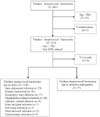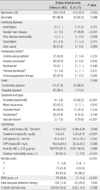Abstract
Background
Materials and Methods
Results
Figures and Tables
 | Figure 1Enrollment of patients with Viridans Streptococcal bacteremia.
aSIRS, systemic inflammatory response syndrome
|
Table 1

IE, infective endocarditis; SOFA, Sequential Organ Failure Assessment
Data are presented as number (%) of patients, unless otherwise indicated.
aPredisposing factors occurred within three months before bacteremia.
bInvasive procedures included extraction of teeth, percutaneous drainage, endoscopic variceal ligation, endoscopic injection sclerotherapy, etc.
cNeutropenia was defined as absolute neutrophil count <500/mm3 for more than three days.
dPrevious steroid use was defined as ≥ Prednisolone 15 mg/day for more than one week.
ePersistent bacteremia was defined as recovery of a microorganism consistent with infective endocarditis from all of three or a majority of four or more separate blood cultures, with first and last drawn at least one hour apart.
fPersistent fever was defined as persistent fever, even though the patient took adequate antibiotic therapy for 48 hours.
gHypotension was defined as Systolic blood pressure <90 mmHg.
hVascular lesions included major arterial emboli, septic pulmonary infarcts, mycotic aneurysm, intracranial hemorrhage, conjunctival hemorrhage, and Janeway lesions.
iPenicillin MIC by E-test
jInitial adequate antibiotic therapy: Therapy was judged to be either adequate or inadequate on the basis of the in vitro susceptibility of an isolated organism and initiation of antibiotic treatment within 48 hours after bacteremia.
Table 2

OR, odds ratio; C.I, confidence interval; SOFA, Sequential Organ Failure Assessment
*Central venous catheter insertion occurred within three months before bacteremia.
aInvasive procedures included extraction of teeth, percutaneous drainage, endoscopicvariceal ligation, endoscopic injection sclerotherapy, etc.
bNeutropenia was defined as absolute neutrophil count <500/mm3 for more than threedays.
cPersistent bacteremia was defined as recovery of a microorganism consistent with infective endocarditis from all of three or a majority of four or more separate blood cultures, with first and last drawn at least one hour apart.
dPersistent fever was defined as persistent fever, even though the patient took adequate antibiotic therapy for 48 hours.
eVascular lesions included major arterial emboli, septic pulmonary infarcts, mycotic aneurysm, intracranial hemorrhage, conjunctival hemorrhage, and Janeway lesions.
Table 3

OR, odds ratio; C.I, confidence interval; SOFA, Sequential Organ Failure Assessment
aVentilator care was defined as patients who took ventilator care within three months before bacteremia for more than three days.
bPrevious hospital stay occurred care within three months before bacteremia
cPrevious steroid use was defined as ≥ prednisolone 15 mg/day for more than one week.
dHypotension was defined as systolic blood pressure <90 mmHg.




 PDF
PDF ePub
ePub Citation
Citation Print
Print


 XML Download
XML Download